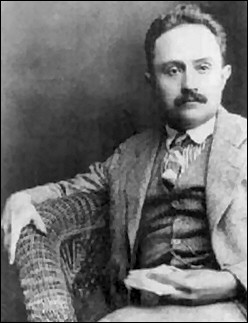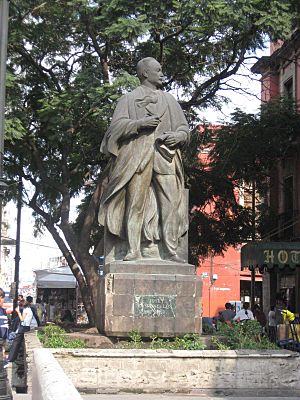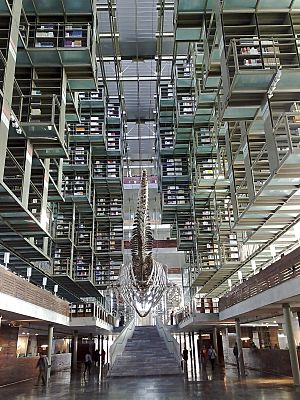José Vasconcelos facts for kids
Quick facts for kids
José Vasconcelos Calderón
|
|
|---|---|

Vasconcelos in 1914
|
|
| 1st Secretary of Public Education | |
| In office 28 September 1921 – 27 July 1924 |
|
| President | Álvaro Obregón |
| Succeeded by | Bernardo J. Gastélum |
| 6th Rector of the National Autonomous University of Mexico |
|
| In office 9 June 1920 – 12 October 1921 |
|
| Preceded by | Balbino Dávalos |
| Succeeded by | Mariano Silva |
| Personal details | |
| Born |
José Vasconcelos Calderón
28 February 1882 Oaxaca, Mexico |
| Died | 30 June 1959 (aged 77) Mexico City, Mexico |
| Resting place | Mexico City Cathedral |
| Political party | National Anti-Reelectionist Party |
| Spouses |
Serafina Miranda
(m. 1906; died 1942)Esperanza Cruz
(m. 1942) |
| Children | José Ignacio, Carmen and Héctor |
| Alma mater | National School of Jurisprudence (ENJ) |
| Profession | Writer, philosopher and politician |
José Vasconcelos Calderón (born February 28, 1882 – died June 30, 1959) was an important Mexican writer, thinker, and politician. He is known as the "cultural leader" of the Mexican Revolution. He played a big role in shaping modern Mexico. His ideas, especially about the "cosmic race", influenced Mexico's culture, politics, and economy.
Contents
Early Life and Education
José Vasconcelos was born in Oaxaca, Oaxaca, Mexico, on February 28, 1882. His father worked for customs. When José was 16, his mother, a devoted Catholic, passed away.
His family moved to Piedras Negras, Coahuila, a town near the border. He went to school in Eagle Pass, Texas, becoming fluent in both English and Spanish. This helped him connect with the English-speaking world. Living near the Texas border likely shaped his idea of the Mexican "cosmic race" and his dislike for Anglo culture.
He studied at the National Preparatory School in Mexico City. Later, he attended law school at Escuela de Jurisprudencia, graduating in 1905.
Family Life
In 1906, at age 24, José married Serafina Miranda. They had two children, José Ignacio and Carmen. After Serafina passed away in 1942, he married pianist Esperanza Cruz. They had a son named Héctor.
Role in the Mexican Revolution
While in law school, Vasconcelos joined a group of students called the Ateneo de la Juventud (Youth Atheneum). This group was against the government of President Porfirio Díaz. They believed in new ideas about how people and society should connect.
After law school, Vasconcelos worked in Washington, D.C. He joined a club there that wanted to remove President Díaz. He returned to Mexico City to help the movement directly. He became a secretary for the Anti-Re-election Party and edited its newspaper.
When Díaz was removed from power, Francisco I. Madero became president. Vasconcelos helped change the academic programs at the National Preparatory School. He moved away from old ideas and brought in new ways of thinking.
After Madero was killed in 1913, Vasconcelos joined the effort to defeat the new leader, Victoriano Huerta. He had to go into exile in Paris, where he met other thinkers and artists. When Huerta was removed in 1914, Vasconcelos came back to Mexico.
He supported a group that tried to find a political solution after the revolution. He served as Minister of Education for a short time. When his side lost a major battle in 1915, Vasconcelos went into exile again.
Leading the National University

Vasconcelos returned to Mexico in 1920. He was named the head, or rector, of the National Autonomous University of Mexico. He had a lot of power and used it to put his ideas into action.
He redesigned the university's logo. It showed a map of Latin America with the motto "Por mi raza hablará el espíritu" (The spirit will speak for my race). This motto showed his belief in the power of education for all people in Latin America. He also said, "I have not come to govern the University but to ask the University to work for the people."
Secretary of Public Education
In 1921, President Álvaro Obregón created the Secretariat of Public Education (SEP). He chose Vasconcelos to lead it. Education became one of the two main spending areas for the government, along with the military.
Vasconcelos traveled across Mexico to get support for the new education department. His efforts worked, and he became the head of the SEP in July 1921.
As Secretary, he had a powerful position to share his vision of Mexico's history and the revolution. He printed many books for the growing public school system. He worked to make education available to everyone.
Later Years and Legacy
Vasconcelos resigned from his position in 1924. He ran for president in 1929 but lost. After that, he left Mexico again.
Later, he directed the National Library of Mexico starting in 1940. He also led the Mexican Institute of Hispanic Culture from 1948.
José Vasconcelos passed away on June 30, 1959, in Mexico City. He was working on a book called Letanías del atardecer when he died. Because of his dedication to education and Latin American culture, he was called "Teacher of the Youth of America," often shortened to "Teacher of America."
Philosophical Ideas
Vasconcelos's early writings were strong reactions against the old, strict way of teaching at the National Preparatory School.
One of his most famous ideas is the "cosmic race" (The Cosmic Race). He believed that mixing different races was a natural and good direction for humanity. This idea helped people think about the value of different ethnic groups.
He also wrote about how humans understand the world through harmony and rhythm. He thought that listening was more important than seeing for truly knowing things.
Influence and Contributions
Vasconcelos is often seen as the founder of the indigenismo philosophy. This idea focused on the importance of Mexico's native cultures. However, some people today criticize it because it also suggested that native groups should blend into a new, "modern" Mexican identity.
His ideas greatly influenced young writers, poets, and thinkers in Mexico and Latin America. He was a guest speaker at universities in the United States, like Columbia and Princeton. His work, La raza cósmica, has been used by Mexican-American groups since the 1970s.
As Secretary of Public Education, Vasconcelos supported the arts. He helped officially recognize the National Symphonic Orchestra. He also allowed famous artists like Diego Rivera, José Clemente Orozco, and David Alfaro Siqueiros to paint murals on public buildings. This started the famous Mexican muralist movement.
Famous Sayings
- "The leaders of Latin American independence... worked to free slaves and declared that all people are equal. In a key moment, they set out the important mission for this part of the world: to unite people ethnically and spiritually." (From La raza cósmica, 1948)
- "Each great nation in history has believed itself to be special. The Hebrews believed in their superiority based on divine promises. The English found theirs by observing animals. From studying how animals breed, Darwinism came about. First, it was a simple animal theory, then it became a social idea that gave the English a final advantage over all other races. Every powerful empire needs a philosophy to justify itself." (From La raza cósmica, 1948)
See also
 In Spanish: José Vasconcelos para niños
In Spanish: José Vasconcelos para niños
- José Vasconcelos Library
- José Vasconcelos World Award of Education
- Moises Saenz






